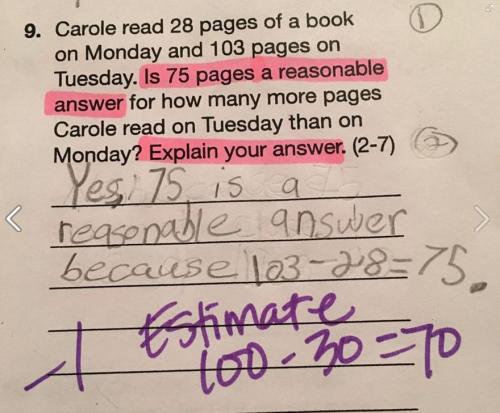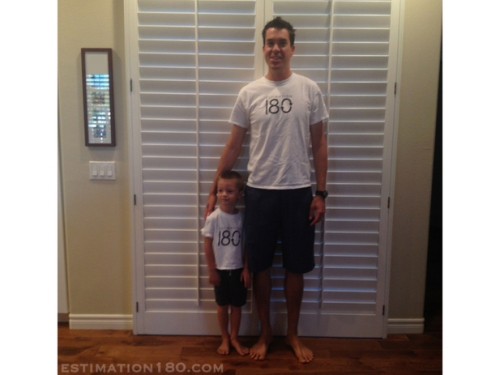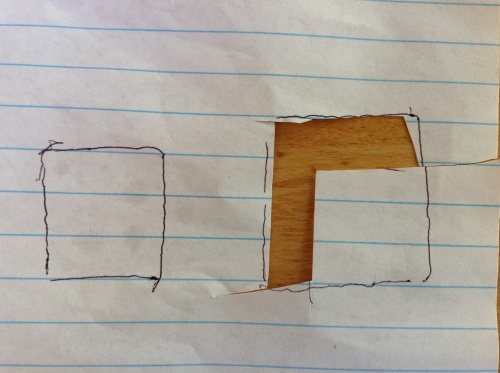Our house in St Paul sits on top of an odd hill; higher than others around it. Historical reasons for this are murky but it makes the place easy for guests to find. One of my least favorite tasks in all of my domestic life is mowing the hill.

For a while now, the precise height of this hill has been the subject of family speculation. One recent lazy summer afternoon, Griffin (8 years old), Tabitha (6 years old) and I found ourselves hanging out on the hill with not much to do.
Me: How tall do you two think the hill is?
Tabitha (6 years old): Five feet.
Griffin (8 years old): I don’t know.
Me: How about this: Which do you think is taller; me or the hill?
T: The hill.
Me: Wait. I’m six feet tall. How can the hill be 5 feet tall AND taller than me?
G: You’re six feet, one inch.
Me: Right. Even so…
T: Oh. I don’t know how tall the hill is, but I think it’s taller than you.
Me: Why?
T: Lie down.

T: See?
Me: Yeah, but just because it’s longer than me doesn’t mean it’s taller than me.
Tabitha seems puzzled by this distinction. Griffin is standing on the sidewalk at my feet.
Me: Look at Griffy’s eyes. Is he looking up or down at my eyes right now?
T: I can’t really tell.
I stand up, right next to Griffy, who cranes his neck back to look me in the eye.
Me: Now?
T: Ha!
I lie back down on the hill.
Me: So how come there’s a difference?
T: You’re lying down now, so that’s not really how tall you are.
Me: So how can we decide whether I am taller, or the hill is?
Nothing much occurs for the next minute or so. We are distracted by butterflies, the edible nature of clover flowers and other wonders of Minnesota’s too-short summers.
Me: Hey! Let’s try this. Tabitha, you go to the top of the hill.
She does, and she stands there, looking down on me with a self-satisfied smile on her face.
Me: OK. So you plus the hill are taller than I am. What about just the hill?
T: I don’t know.
Me: Lie down.
She does, although it takes a few tries to achieve the desired position by which she can look at me from roughly the level of the top of the hill.
Me: Are you looking up or down at me?
T: I can’t tell.
Griffin takes his turn at the top of the hill. He, too, is unsure.
Me: So how can we be sure?
T: You know, Daddy, I don’t really need to know this.
Me: You’re right. You don’t. Nor do I, really. But I have always been curious how tall the hill is. Aren’t you?
G: We could measure a step, then use the number of steps to figure out how tall it is.
I obtain a tape measure.
We determine that each step is 7 inches tall. We notice that the bottom step is shorter than the rest and measure it at 5 inches. Griffin laboriously counts the steps, finding that there are eight of them, plus the smaller one.
G: So what is that altogether?
Me: What? You can do this.
G: Do you know whether you are taller than the hill?
Me: Actually, yes I do, even though I don’t know exactly how tall the hill is.
G: If I figure it out, will tell me whether I’m right?
Me: Yes.
G: [Far too quickly for me to be convinced he has run any computations at all] OK. The hill is taller.
Me: How do you know?
G: Hey! You said you would tell me!
Me: That’s part of doing the math!
G: OK.
A long, thoughtful pause ensues.
G: Eight eights is 64, plus 5 is 69. So you are taller.
Me: But you need eight sevens, which is 56.
G: Oh. Right. Plus 5.
Me: Yes…?
G: Tell me.
Child, please.
Me: Seriously? You can do 56 plus 5.
G: 61.
Me: Yes, and I’m 73 inches tall.
Tabitha, despite her protestations about not needing to know, has been paying attention all along.
T: You’re taller than the hill?
Me: Yes. See? I told you it was interesting.
G: You knew you were taller?
Me: Yes. But I didn’t realize it was by a foot. I thought it would be only by a few inches.
G: How did you know?
Me: Because I look down—only slightly—but I look down at the top of the hill.
In a few days, we will return to the topic of the State Fair Giant Slide and see whether these techniques generalize in my children’s minds.












